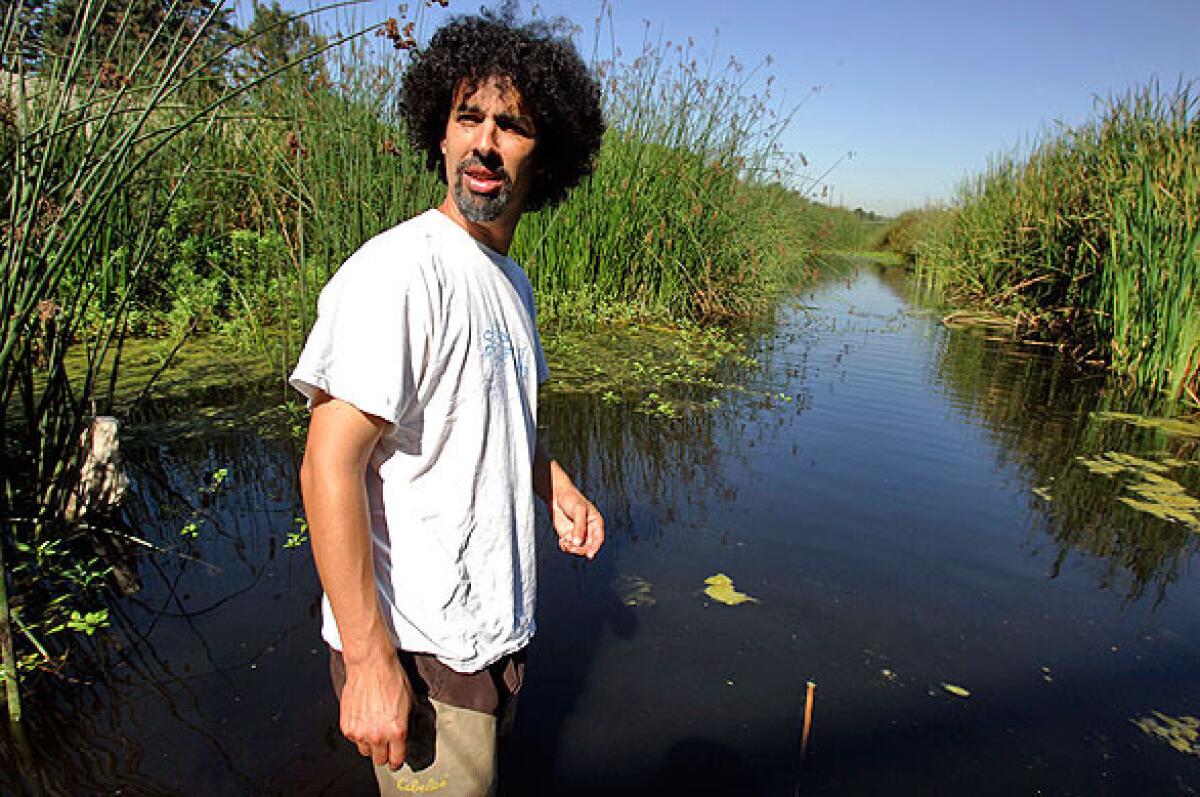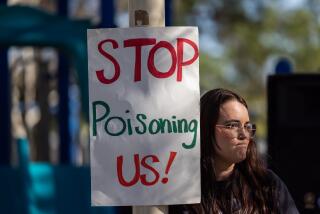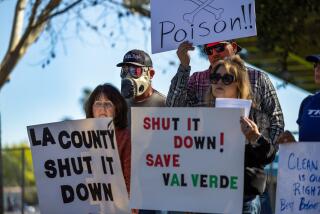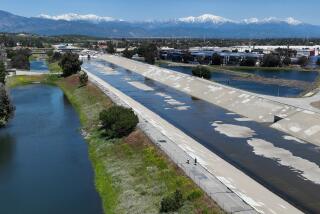Environmentalists torn up over Compton Creek bulldozing

Knee deep in Compton Creek’s murky waters, environmentalist James Alamillo scanned the ripples for signs of aquatic life in a stretch edged with cattails and trash, between a Metro Rail station and heavy industry just north of the 710 Freeway.
“What have we here? A crawdad,” he said, smiling down on the creature as it scooted backward over his waterproof boots. “We also have a lot of this sort of thing,” he grumbled, reaching into the water and yanking out a clump of discarded electrical wiring.
He heaved the garbage onto the riverbank.
Alamillo, a spokesman for the Santa Monica-based conservation group Heal the Bay, had gone out last week to call attention to the plight of the creek’s earthen-bottom portion, which meanders for eight miles through some of Southern California’s most densely populated and heavily industrialized regions. Decades of illegal dumping and storm drain runoff have loaded the channel with debris and laced its water with industrial waste.
Then there is the annual September bulldozing of debris and creek vegetation -- all impediments that could block the flow of water -- by Los Angeles County flood control crews.
“It’s a catastrophe that happens over and over -- and it’s happening again,” Alamillo said. “Come back in a few days and it’ll look like a bomb was dropped on this place.”
Environmental groups, including Heal the Bay and Friends of the Los Angeles River, want the county to weigh other, less destructive ways of managing the channel. County authorities, however, insist the operations are needed to protect lives and property during Southern California’s storm season.
“There has to be a way to protect property and human lives without destroying all of nature at the same time with heavy machinery,” said Mark Gold, president of Heal the Bay. “If that means using labor-intensive hand crews to remove debris and trash and maintain vegetation, then so be it.”
Mark Pestrella, deputy director of the Los Angeles County Department of Public Works, said Gold misses the point.
“If we had to clear that channel of debris and vegetation by hand, it would take more than three years,” he said. “We use bulldozers because they are an effective way of clearing the channel of debris that could inhibit our ability to provide flood protection.”
For the last three decades, Compton Creek stakeholders -- civic leaders, homeowners, regulatory agencies, county engineers, environmentalists, developers -- have tried to find common ground.
Compounding problems, county flood control authorities say, the channel’s levee system does not meet federal flood standards. As a result, the system must be upgraded to avoid creating a serious flood risk in Compton, a city of about 93,500 residents, 28% of whom live below the poverty line.
Overall, Compton Creek is about 20 miles long and runs through several cities north and south of Compton en route to the Los Angeles River and then the ocean.
It is cherished by environmentalists as a remnant of wildlife habitat in a sea of asphalt and traffic.
Earlier this year, conservation groups opposed renewal of the five-year permit that allows the Public Works Department to bulldoze the creek and the Long Beach estuary, about 10 miles farther south, pending a review of less destructive alternatives.
Instead, the permit was approved Sept. 3 -- by default.
That is because the permit application was submitted to the California Regional Water Quality Control Board more than a year ago. Under the U.S. Clean Water Act, if the board fails to act on a permit request within a year, it automatically goes into effect.
“Much to my embarrassment, we missed the deadline by about two months,” said Tracy Egoscue, the water board’s executive officer. “So the county got a de facto approval.”
Los Angeles County Supervisor Mark Ridley-Thomas recently joined the Compton Creek controversy with a plan he hopes will bring antagonistic parties together.
In June, the Board of Supervisors approved his motion directing the Public Works Department to work with all jurisdictions within the watershed, including the cities of Compton, Los Angeles and Long Beach, to develop a Compton Creek master plan.
The plan, which will take two to five years to complete, will include strategies for revitalizing as many portions of the creek as possible with bike paths, pocket parks and restored habitat.
Whether the plan will spark a renaissance remains to be seen. After all, the creek is already under review by more than a dozen groups, including the Los Angeles and San Gabriel Rivers Watershed Council, the Rivers and Mountains Conservancy, and the Compton Creek Task Force, led by Compton City Councilwoman Yvonne Arceneaux.
A week ago, community leaders, elected officials and business owners met at a casino in Compton with a goal of identifying opportunities for economic development and habitat restoration.
Alamillo had more immediate concerns during his visit to Compton Creek.
Four bulldozers, two dump trucks and two water tenders were methodically stripping a mile-long stretch of the creek north of Del Amo Boulevard of its greenery.
As the heavy machinery advanced, flocks of startled red-winged blackbirds fluttered out of dense stands of cattails up to 7 feet tall. A rabbit dashed toward higher ground. A heron-like bittern flew out of the path of one bulldozer, then another. Dragonflies and butterflies scattered in all directions.
“There’s got to be a better way,” Alamillo said, shaking his head.
More to Read
Start your day right
Sign up for Essential California for news, features and recommendations from the L.A. Times and beyond in your inbox six days a week.
You may occasionally receive promotional content from the Los Angeles Times.







